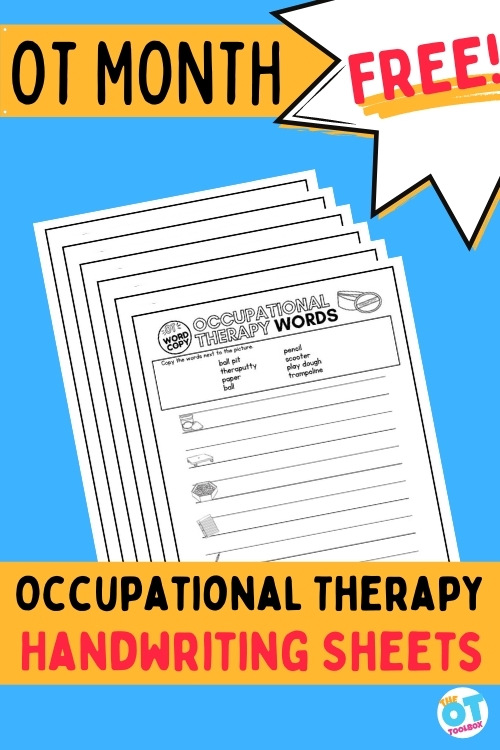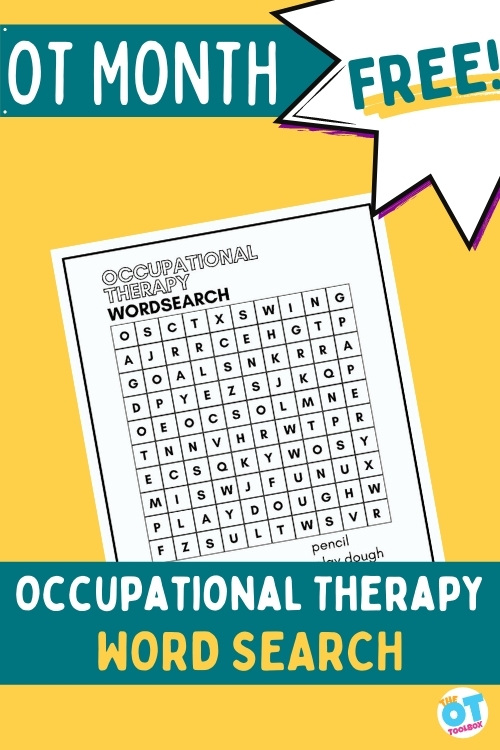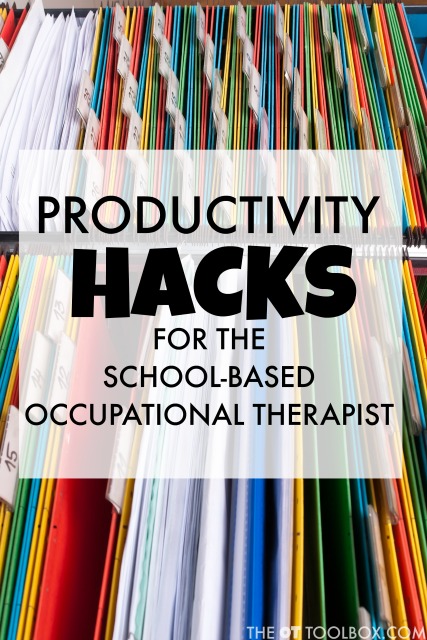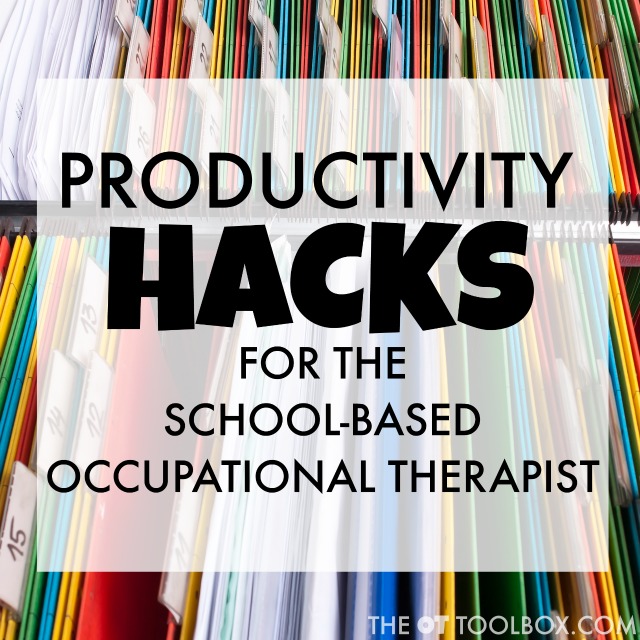Today, we have another OT PDF, this one is an occupational therapy equipment list. We created this printable list of OT equipment as a writing exercise. It’s another free download that you’ll want to grab for OT month! For occupational therapy month, we’ve been sharing free OT-themed tools and this occupational therapy equipment list handwriting pages is today’s freebie! Pediatric occupational therapists have some cool tools, so why not use those OT equipment items in handwriting practice? It’s a great way to promote the profession during OT month and all year long!
OT practitioners work with clients on myriad aspects of daily life tasks. Because an OT professional can support their clients in essentially any aspect of living, the equipment used is vast and can be unique to each individual. However, the OT or OTA has a commonly used list of occupational therapy equipment that is found in almost every OT clinic or therapy bag. In today’s blog post, you’ll find an occupational therapy equipment list PDF which providers can print off to use as a handwriting exercise with clients and students. Put those OT items students use each therapy session to greater use!
Amazon affiliate links are included in this blog post. As an Amazon Influencer, I earn from qualifying purchases.

Occupational Therapy Equipment List
Occupational therapy (OT) helps people become more independent. Whether it is babies, toddlers, students, people who are disabled or have had an accident, or those being rehabilitated from surgery, OT’s play a vital role.
The cool thing is that OT equipment can literally be anything that helps people achieve functional goals, in any aspect of life!
OT equipment items could be the toys, tools, and games that help to develop skills:
- Toys
- Games
- Scooter boards
- Theraputty exercises
- Trampolines
- Slant boards
- Swings
- Ball pit (Use the writing list along with these ball pit activities!)
- Paper
- Pencil
- Weighted materials
- Puzzles
This list of OT items are just the beginning of our arsenal of tools!
When it comes to school-based occupational therapy and outpatient occupational therapy equipment, there can be differences based on the educational modal vs. the medical modal of therapy intervention.
Having the right equipment and tools is essential for facilitating the development and progress of students. Here’s a list of commonly used occupational therapy equipment for school-based OT:
- Fine Motor Therapy Tools:
- Pencil grips or adaptive writing tools for improved grip and control.
- Precision toys
- Tweezers or tongs and small objects to manipulate
- Coins and slotted containers
- Scissors with spring-loaded handles or loop scissors to assist with cutting skills.
- Play dough or thera-putty
- Paper for coloring drawing, cutting and tearing
- Manipulative toys like pegboards, lacing cards, and building blocks to enhance fine motor coordination
- Sensory Integration/Sensory Processing Tools:
- Sensory balls or therapy putty for tactile stimulation and hand strengthening.
- Sensory play materials like sensory bins, shaving cream, writing tray materials, etc.
- Weighted blankets or vests to provide calming input and promote self-regulation.
- Therapeutic swings or therapy bands for vestibular and proprioceptive input.
- Ball pit
- Fidget toys
- Tunnels
- Floor markers, masking tape for obstacle courses
- Deep breathing exercises
- Seating and Positioning Aids:
- Adaptive seating options like wobble cushions, therapy balls, or stability discs to improve posture and core stability.
- Adjustable-height desks or tables to accommodate different student needs.
- Lap trays or angled writing boards to provide a stable surface for writing and activities.
- Cognitive Tools:
- Visual timers or schedules to assist with time management and organization skills.
- Memory games, puzzles, or matching activities to enhance cognitive skills
- Cooking activities and materials
- Games
- Visual schedules
- Checklists
- Scheduling tools and planners
- Visual Processing Tools:
- Visual supports such as visual schedules, picture cards, or visual cueing systems for task completion and transition support.
- Mazes
- Puzzles
- I Spy
- Word search activities
- Gross Motor Equipment:
- Balance beams
- therapy balls or therapy mats for improving balance and coordination
- Scooters, tricycles, or adaptive bikes
- Cones or targets for obstacle courses
- Mini trampoline
- Masking tape for obstacle courses
- Hula hoops
- Bean bags for gross motor games
- Adaptive Tools for Self-Care:
- Adaptive utensils, plates, or cups for promoting independence in eating and drinking.
- Adaptive paper for addressing handwriting skills
- Dressing aids such as buttonhooks, zipper pulls, or elastic shoelaces for developing self-care skills.
- Adaptive equipment for toileting, including raised toilet seats or step stools.
- Assistive Technology:
- Alternative keyboards, computer mice, or speech-to-text software for students with fine motor or writing difficulties.
- OT apps
- Visual or auditory aids, such as timers or reminders, on tablets or smartphones to support organization and time management.
While these look like toys (and in some cases are), they are often valuable tools to build independence, strength, focus, and help bridge the gap between functional and chronological age.
Use this word copying worksheet to talk about what each of these tools are, while building some great skills.
Amazon has great occupational therapy equipment and OT tools and we’ve created a bunch of (Amazon affiliate link) OT equipment lists and suggestions for OT toys and tools.
We serve people from birth to the end of life. Did you know that April is OT Month? A month-long celebration to advocate for the work we do. The OT Toolbox will be offering several valuable activities to share with your learners to educate them about our role.
Occupational Therapy Equipment List Handwriting Worksheets
Today’s freebies are occupational therapy tools handwriting worksheets.
These occupational therapy equipment handwriting worksheets PDF highlight just a handful of the tools we use to help learners grow.
The occupational therapy tools, handwriting activity is presented with two sets of lines, to use with different levels of learners. Each picture is presented in simple black and white to encourage coloring as well as copying the words.
How can I modify this task to work with all groups of learners?
- Lowest level learners can cut and paste the words into the correct rows
- Middle level learners can copy each word into the lines
Use OT equipment writing lists.
- Higher level learners can write a sentence using the key words or write how these items can be used in therapy
- Take away the word bank for higher level learners to sound out the words, or dictate the spelling aloud for a higher level challenge
- Make this occupational therapy, copy the word sheet part of a larger lesson plan including gross motor, sensory, social, executive function, or other fine motor skills
- Print in black and white or color for different levels of difficulty
- Cut the shapes and make a matching activity instead of using a writing tool to copy the words
- Talk about the equipment, describe their characteristics, and give context clues to help your learner understand why these tools are helpful
- Enlarging the font may be necessary to beginning handwriting students who need bigger space to write.
- Project this page onto a smart board for students to come to the board and write in big letters.
- More or less prompting may be needed to grade the activity to make it easier or harder.
- More advanced learners can work on social skills by talking to the group about these therapy tools
- Write a report about occupational therapy, types of equipment, the history of OT, different disabilities, or how the equipment is used
- Turn it into a gross motor task, sensory activity, following directions, or combination of all of these
- Work in pairs or in a small group to address problem solving, turn taking, and sharing information with others
Talk to young learners about the role of occupational therapy
It is difficult enough to talk to adults about what occupational therapists do. Now try describing this to a group of first graders! If you describe it as playing on swings, trampolines, riding scooters, and getting fun fidgets, you will have everyone in the school trying to figure out a way to sign up for OT!
Instead talk about the kinds of goals we address, and how we help other students to be more independent using the tools described on the occupational therapy tools, handwriting worksheet.
Start the conversation to promote the OT Profession
The conversation about what occupational therapists do might sound like this:
- OTs might help a student who can not open all their lunch containers by themselves
- If a student can not use the bathroom independently, put on their coat, wash hands, or eat their lunch with utensils, they might need occupational therapy
- Not everyone is able to write their letters, cut, and color like the rest of the class. OTs work on helping students to improve these skills so they can keep up with the class
- Some students have difficulty making friends, playing with other people, following directions, sharing, taking turns, or standing in line. Some of these students might need occupational therapy to help them with these skills
- Have you noticed some students get in trouble at school? They don’t finish their work, their stuff is a mess, they don’t listen to the teacher very well, and seem to make a lot of mistakes? These are not bad students, they may need some help to get better. There is a whole team to help students like these, OTs are one of them.
- How do you think some of the items on the occupational therapy tools handwriting worksheet help students?
The month of April is specially dedicated to sharing our knowledge with other people. Take a moment to give yourself a pat on the back while you are at it! Keep an eye out for several posts this month dedicated to advocating for the OT profession.
Free OT Equipment Worksheets
Grab these OT equipment list handwriting worksheets and get started to open conversations about what we do as occupational therapists! AND work on the functional task of handwriting skills during your conversations.
Want to add this resource to your therapy toolbox so you can help kids thrive? Enter your email into the form below to access this printable tool.
This resource is just one of the many tools available in The OT Toolbox Member’s Club. Each month, members get instant access to downloadable activities, handouts, worksheets, and printable tools to support development. Members can log into their dashboard and access all of our free downloads in one place. Plus, you’ll find exclusive materials and premium level materials.
Level 1 members gain instant access to all of the downloads available on the site, without enter your email each time PLUS exclusive new resources each month.
Level 2 members get access to all of our downloads, exclusive new resources each month, PLUS additional, premium content each month: therapy kits, screening tools, games, therapy packets, and much more. AND, level 2 members get ad-free content across the entire OT Toolbox website.
Join the Member’s Club today!
Don’t miss the other OT month freebies! This month the OT Toolbox is highlighting occupational therapy month by providing insight into what occupational therapists do, along with offering FREE resources to add to your lesson plans. Keep an eye out for more posts from this series, including:
- (FREE) OT Fine Motor Game
- (FREE) OT Coloring Pages
- (FREE) Occupational Therapy Word Search
- (FREE) Occupational Therapy Match it Game

Victoria Wood, OTR/L is a contributor to The OT Toolbox and has been providing Occupational Therapy treatment in pediatrics for more than 25 years. She has practiced in hospital settings (inpatient, outpatient, NICU, PICU), school systems, and outpatient clinics in several states. She has treated hundreds of children with various sensory processing dysfunction in the areas of behavior, gross/fine motor skills, social skills and self-care. Ms. Wood has also been a featured speaker at seminars, webinars, and school staff development training. She is the author of Seeing your Home and Community with Sensory Eyes.







